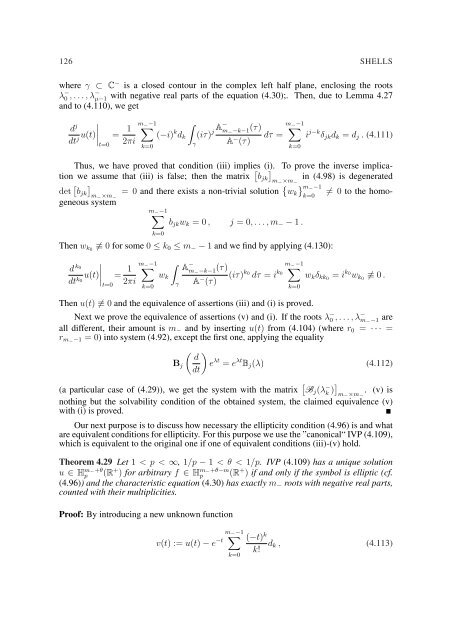EQUATIONS OF ELASTIC HYPERSURFACES
EQUATIONS OF ELASTIC HYPERSURFACES
EQUATIONS OF ELASTIC HYPERSURFACES
You also want an ePaper? Increase the reach of your titles
YUMPU automatically turns print PDFs into web optimized ePapers that Google loves.
126 SHELLS<br />
where γ ⊂ C − is a closed contour in the complex left half plane, enclosing the roots<br />
λ − 0 , . . . , λ − µ−1 with negative real parts of the equation (4.30);. Then, due to Lemma 4.27<br />
and to (4.110), we get<br />
∣<br />
d j ∣∣∣t=0<br />
dt u(t) = 1<br />
m − −1<br />
∑<br />
∫<br />
(−i) k d j k<br />
2πi<br />
k=0<br />
γ<br />
(iτ) j A− m − −k−1 (τ)<br />
A − (τ)<br />
dτ =<br />
m − −1<br />
∑<br />
k=0<br />
i j−k δ jk d k = d j . (4.111)<br />
m − ×m −<br />
Thus, we have proved that condition (iii) implies (i). To prove the inverse implication<br />
we assume that (iii) is false; then the matrix [ b jk<br />
]m − ×m −<br />
in (4.98) is degenerated<br />
det [ ]<br />
b jk = 0 and there exists a non-trivial solution { } m− −1<br />
w k ≠ 0 to the homo-<br />
k=0<br />
geneous system<br />
m − −1<br />
∑<br />
k=0<br />
b jk w k = 0 , j = 0, . . . , m − − 1 .<br />
Then w k0 ≢ 0 for some 0 ≤ k 0 ≤ m − − 1 and we find by applying (4.130):<br />
∣<br />
d k 0 ∣∣∣t=0<br />
dt u(t) = 1<br />
m − −1<br />
∑<br />
∫<br />
w k k<br />
0 2πi<br />
k=0<br />
γ<br />
A − m − −k−1 (τ)<br />
(iτ) k 0<br />
dτ = i k 0<br />
A − (τ)<br />
m − −1<br />
∑<br />
Then u(t) ≢ 0 and the equivalence of assertions (iii) and (i) is proved.<br />
k=0<br />
w k δ kk0 = i k 0<br />
w k0 ≢ 0 .<br />
Next we prove the equivalence of assertions (v) and (i). If the roots λ − 0 , . . . , λ − m − −1 are<br />
all different, their amount is m − and by inserting u(t) from (4.104) (where r 0 = · · · =<br />
r m− −1 = 0) into system (4.92), except the first one, applying the equality<br />
B j<br />
( d<br />
dt<br />
)<br />
e λt = e λt B j (λ) (4.112)<br />
(a particular case of (4.29)), we get the system with the matrix [ B j (λ − k )] m − ×m −<br />
. (v) is<br />
nothing but the solvability condition of the obtained system, the claimed equivalence (v)<br />
with (i) is proved.<br />
Our next purpose is to discuss how necessary the ellipticity condition (4.96) is and what<br />
are equivalent conditions for ellipticity. For this purpose we use the ”canonical“ IVP (4.109),<br />
which is equivalent to the original one if one of equivalent conditions (iii)-(v) hold.<br />
Theorem 4.29 Let 1 < p < ∞, 1/p − 1 < θ < 1/p. IVP (4.109) has a unique solution<br />
u ∈ H m −+θ<br />
p (R + ) for arbitrary f ∈ H m −+θ−m<br />
p (R + ) if and only if the symbol is elliptic (cf.<br />
(4.96)) and the characteristic equation (4.30) has exactly m − roots with negative real parts,<br />
counted with their multiplicities.<br />
Proof: By introducing a new unknown function<br />
m − −1<br />
∑<br />
v(t) := u(t) − e −t<br />
k=0<br />
(−t) k<br />
d k , (4.113)<br />
k!

















